Douglas C-47 on:
[Wikipedia]
[Google]
[Amazon]
The Douglas C-47 Skytrain or Dakota ( RAF,
 Large numbers of DC-3s and surplus C-47s were in commercial use in the United States in the 1940s. In response to proposed changes to the Civil Air Regulations airworthiness requirements that would limit the continuing use of these aircraft, Douglas offered a late-1940s DC-3 conversion to improve takeoff and single-engine performance. This new model, the DC-3S or "Super DC-3", was 39 in (0.99 m) longer. It allowed 30 passengers to be carried, with increased speed to compete with newer airliners. The rearward shift in the center of gravity led to larger tail surfaces and new outer, swept-back wings. More powerful engines were installed along with shorter, jet ejection-type exhaust stacks. These were either 1,475 hp (1,100 kW)
Large numbers of DC-3s and surplus C-47s were in commercial use in the United States in the 1940s. In response to proposed changes to the Civil Air Regulations airworthiness requirements that would limit the continuing use of these aircraft, Douglas offered a late-1940s DC-3 conversion to improve takeoff and single-engine performance. This new model, the DC-3S or "Super DC-3", was 39 in (0.99 m) longer. It allowed 30 passengers to be carried, with increased speed to compete with newer airliners. The rearward shift in the center of gravity led to larger tail surfaces and new outer, swept-back wings. More powerful engines were installed along with shorter, jet ejection-type exhaust stacks. These were either 1,475 hp (1,100 kW)
 The C-47 was vital to the success of many Allied campaigns, in particular, those at
The C-47 was vital to the success of many Allied campaigns, in particular, those at
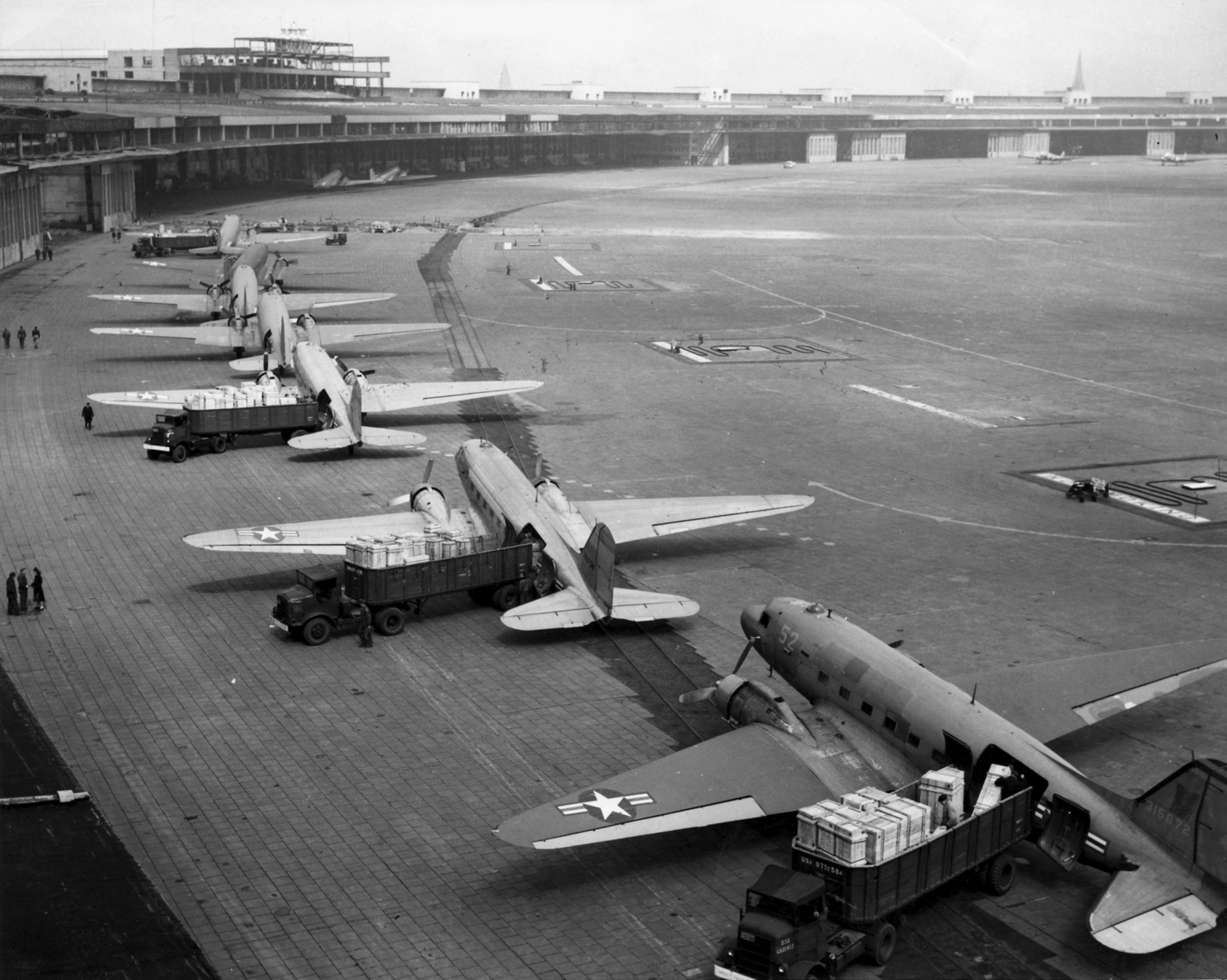 The
The


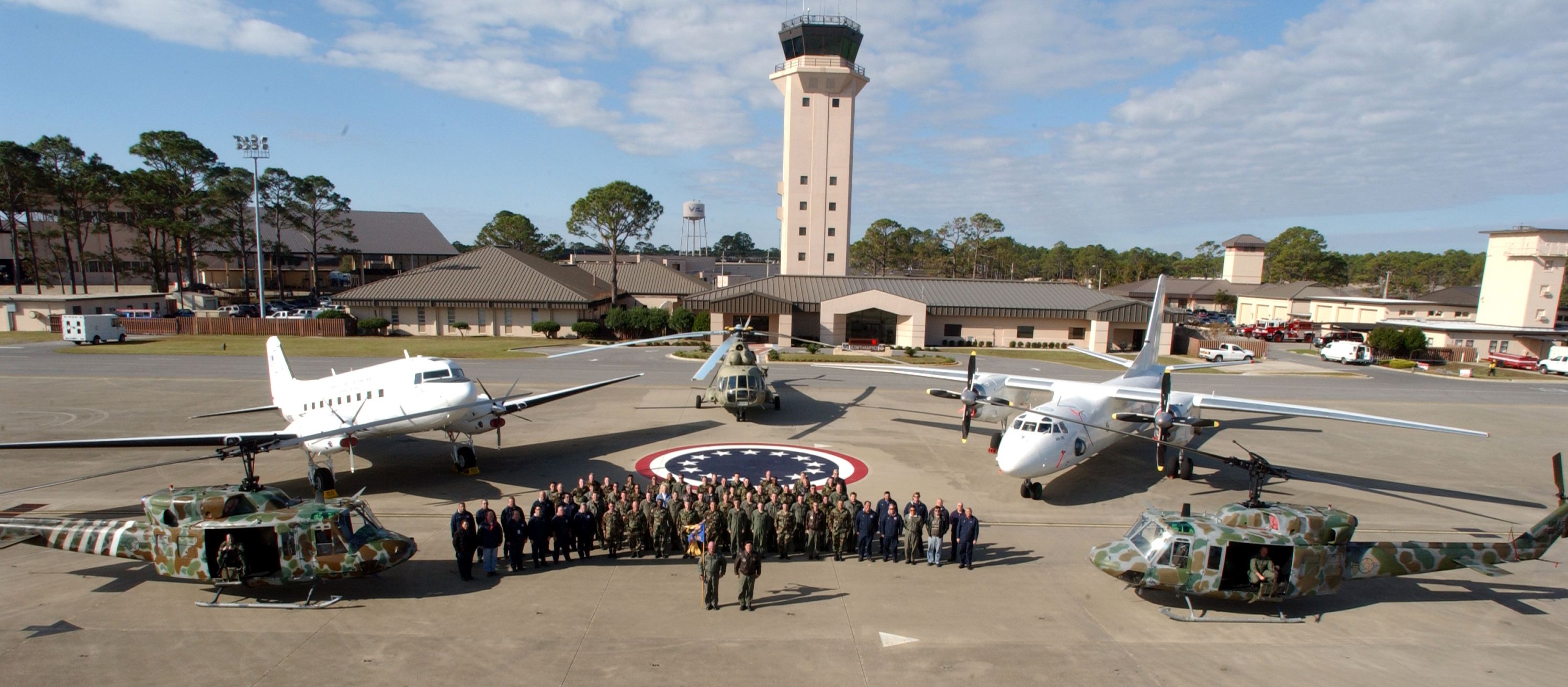
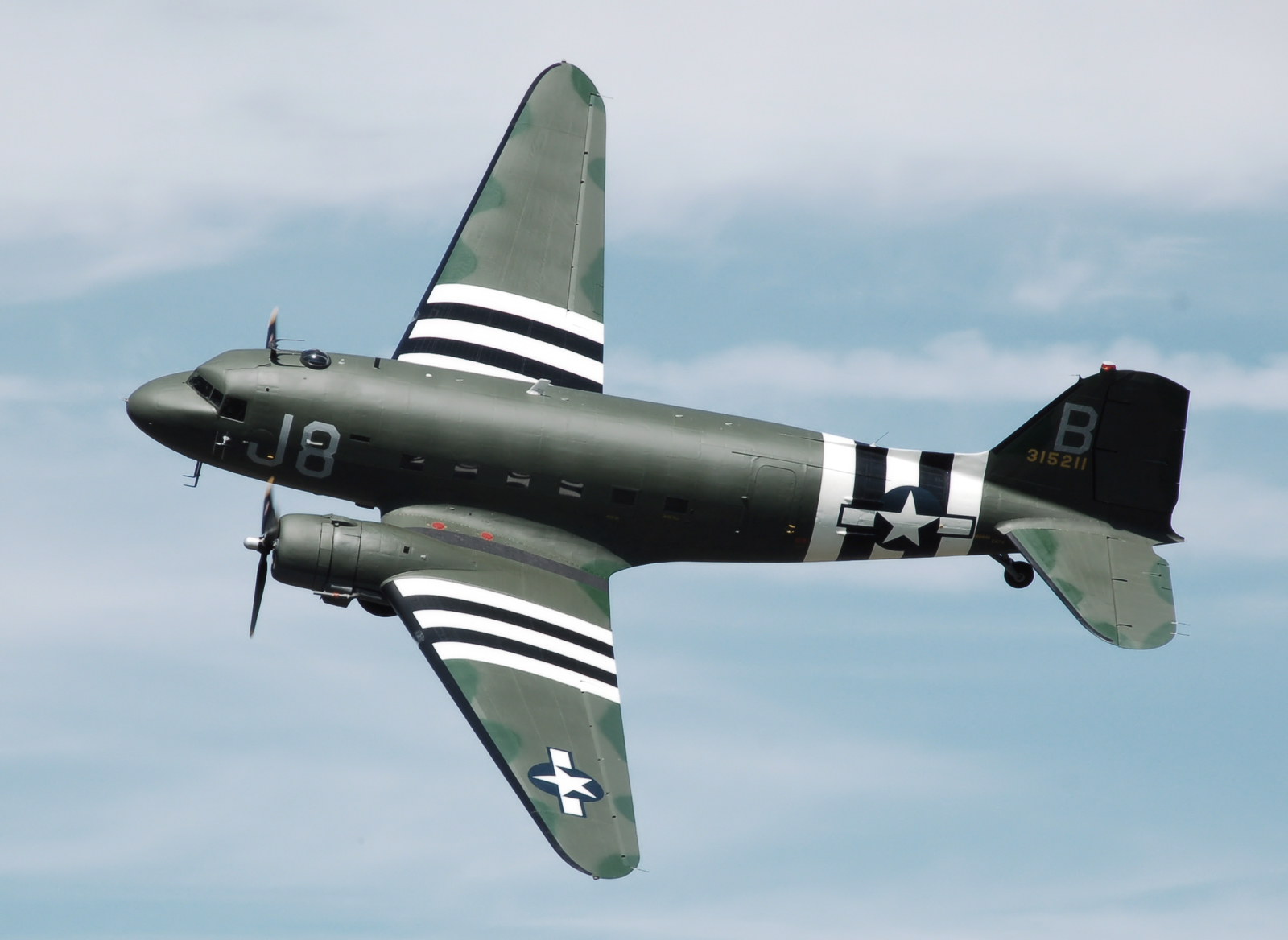
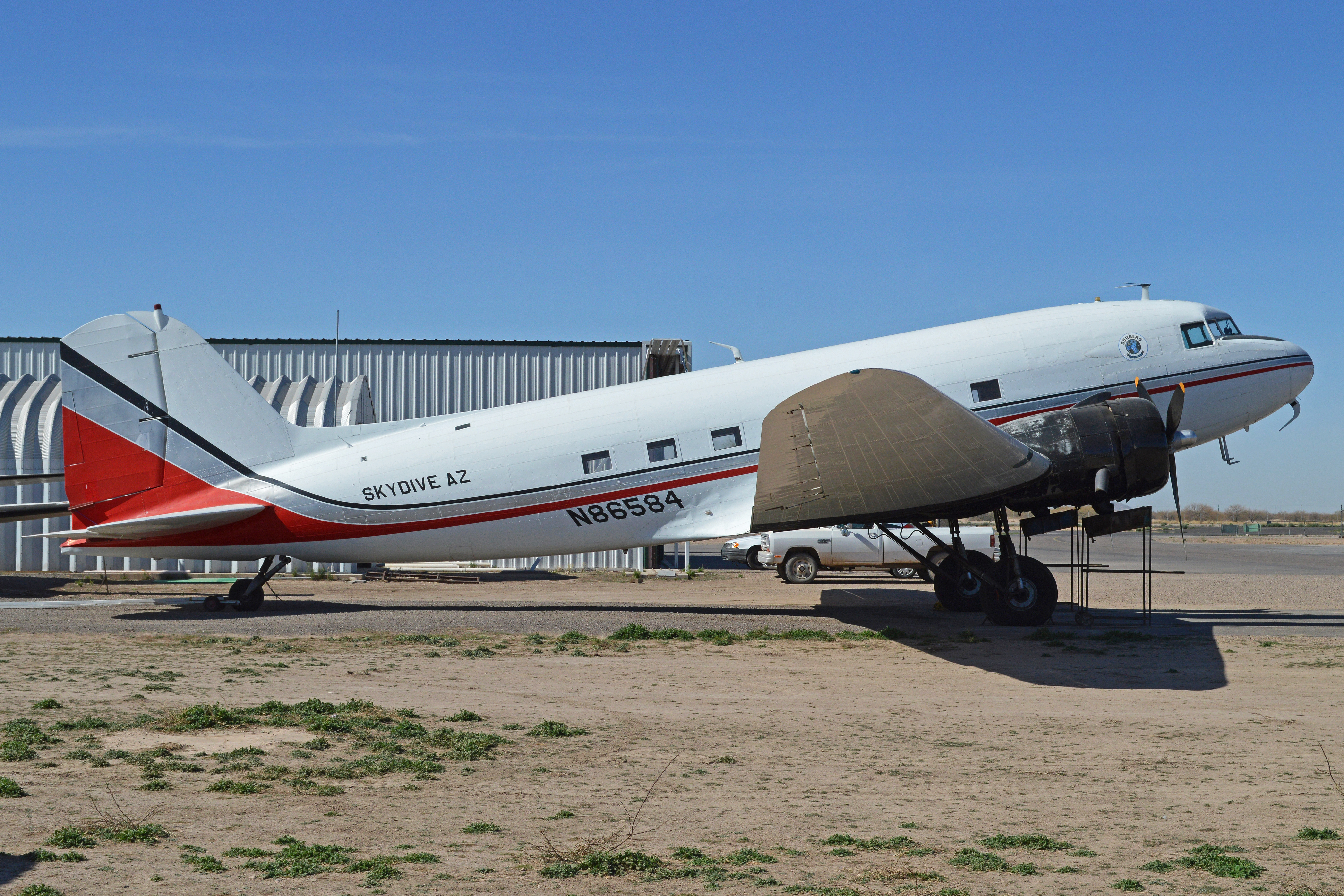 ;C-47
:Initial military version of the DC-3 had four crew (pilot, co-pilot, navigator, and radio operator) and seats for 27 troops alongside the fuselage interior. "Aerial Ambulances" fitted for casualty evacuation could carry 18 stretcher cases and a medical crew of three; 965 built (including 12 for the United States Navy as R4D-1).
;
:C-47 with a 24-volt electrical system, 5,254 built including USN aircraft designated R4D-5
;RC-47A
:C-47A equipped for photographic reconnaissance and ELINT missions
;SC-47A
:C-47A equipped for Search Air Rescue; redesignated HC-47A in 1962
;VC-47A
:C-47A equipped for VIP transport role
;C-47B
:Powered by R-1830-90 engines with two-speed superchargers (better altitude performance) to cover the
;C-47
:Initial military version of the DC-3 had four crew (pilot, co-pilot, navigator, and radio operator) and seats for 27 troops alongside the fuselage interior. "Aerial Ambulances" fitted for casualty evacuation could carry 18 stretcher cases and a medical crew of three; 965 built (including 12 for the United States Navy as R4D-1).
;
:C-47 with a 24-volt electrical system, 5,254 built including USN aircraft designated R4D-5
;RC-47A
:C-47A equipped for photographic reconnaissance and ELINT missions
;SC-47A
:C-47A equipped for Search Air Rescue; redesignated HC-47A in 1962
;VC-47A
:C-47A equipped for VIP transport role
;C-47B
:Powered by R-1830-90 engines with two-speed superchargers (better altitude performance) to cover the  ;R4D-6
::157 C-47Bs transferred to USN; redesignated C-47J in 1962
;R4D-6L, Q, R, S, and Z
:Variants as the R4D-5 series; redesignated LC-47J, EC-47J, TC-47J, SC-47J, and VC-47J respectively in 1962
;R4D-7
:44 TC-47Bs transferred from USAF for use as a navigational trainer; redesignated TC-47K in 1962
;
;R4D-6
::157 C-47Bs transferred to USN; redesignated C-47J in 1962
;R4D-6L, Q, R, S, and Z
:Variants as the R4D-5 series; redesignated LC-47J, EC-47J, TC-47J, SC-47J, and VC-47J respectively in 1962
;R4D-7
:44 TC-47Bs transferred from USAF for use as a navigational trainer; redesignated TC-47K in 1962
;
 ;Dakota I
:RAF designation for the C-47 and R4D-1.
;Dakota II
:RAF designation for nine C-53 Skytroopers received under the lend lease scheme. Unlike the majority of RAF Dakotas, these aircraft were therefore dedicated troop transports, lacking the wide cargo doors and reinforced floor of the C-47.
;Dakota III
:RAF designation for the C-47A.
;Dakota IV
:RAF designation for the C-47B.
;Airspeed AS.61
:Projected conversion of Dakota I aircraft by Airspeed. None built.
;Airspeed AS.62
:Projected conversion of Dakota II aircraft by Airspeed. None built.
;Airspeed AS.63
:Projected conversion of Dakota III aircraft by Airspeed. None built.
;BEA Pionair/Dart-Dakota
:Conversion of Dakota to
;Dakota I
:RAF designation for the C-47 and R4D-1.
;Dakota II
:RAF designation for nine C-53 Skytroopers received under the lend lease scheme. Unlike the majority of RAF Dakotas, these aircraft were therefore dedicated troop transports, lacking the wide cargo doors and reinforced floor of the C-47.
;Dakota III
:RAF designation for the C-47A.
;Dakota IV
:RAF designation for the C-47B.
;Airspeed AS.61
:Projected conversion of Dakota I aircraft by Airspeed. None built.
;Airspeed AS.62
:Projected conversion of Dakota II aircraft by Airspeed. None built.
;Airspeed AS.63
:Projected conversion of Dakota III aircraft by Airspeed. None built.
;BEA Pionair/Dart-Dakota
:Conversion of Dakota to

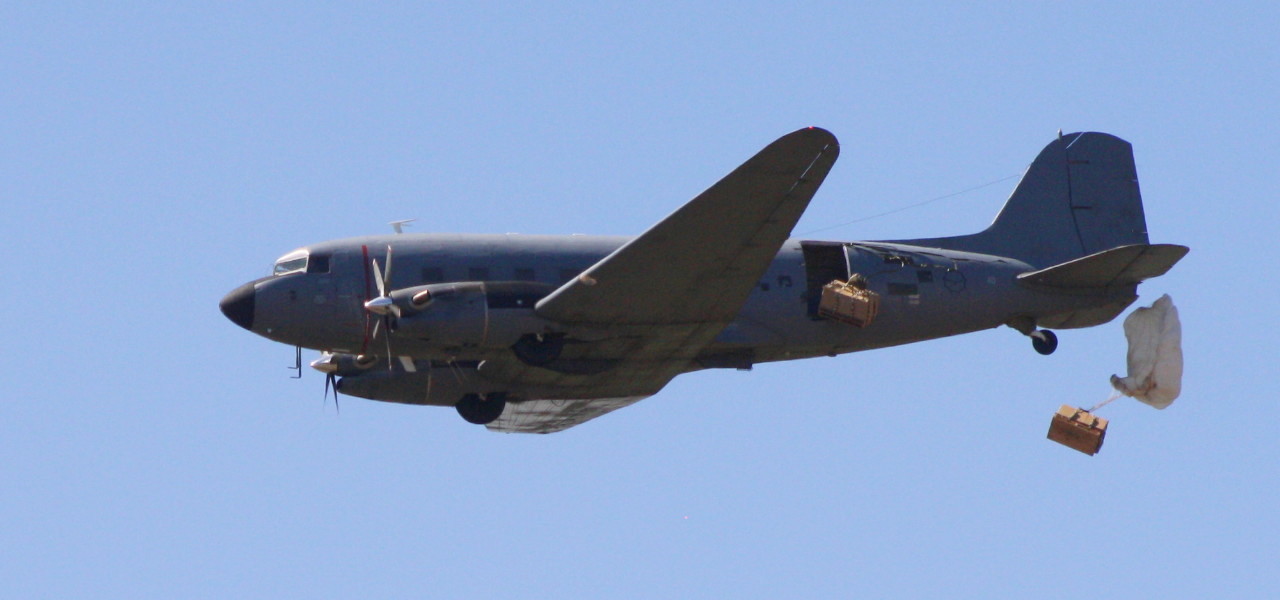
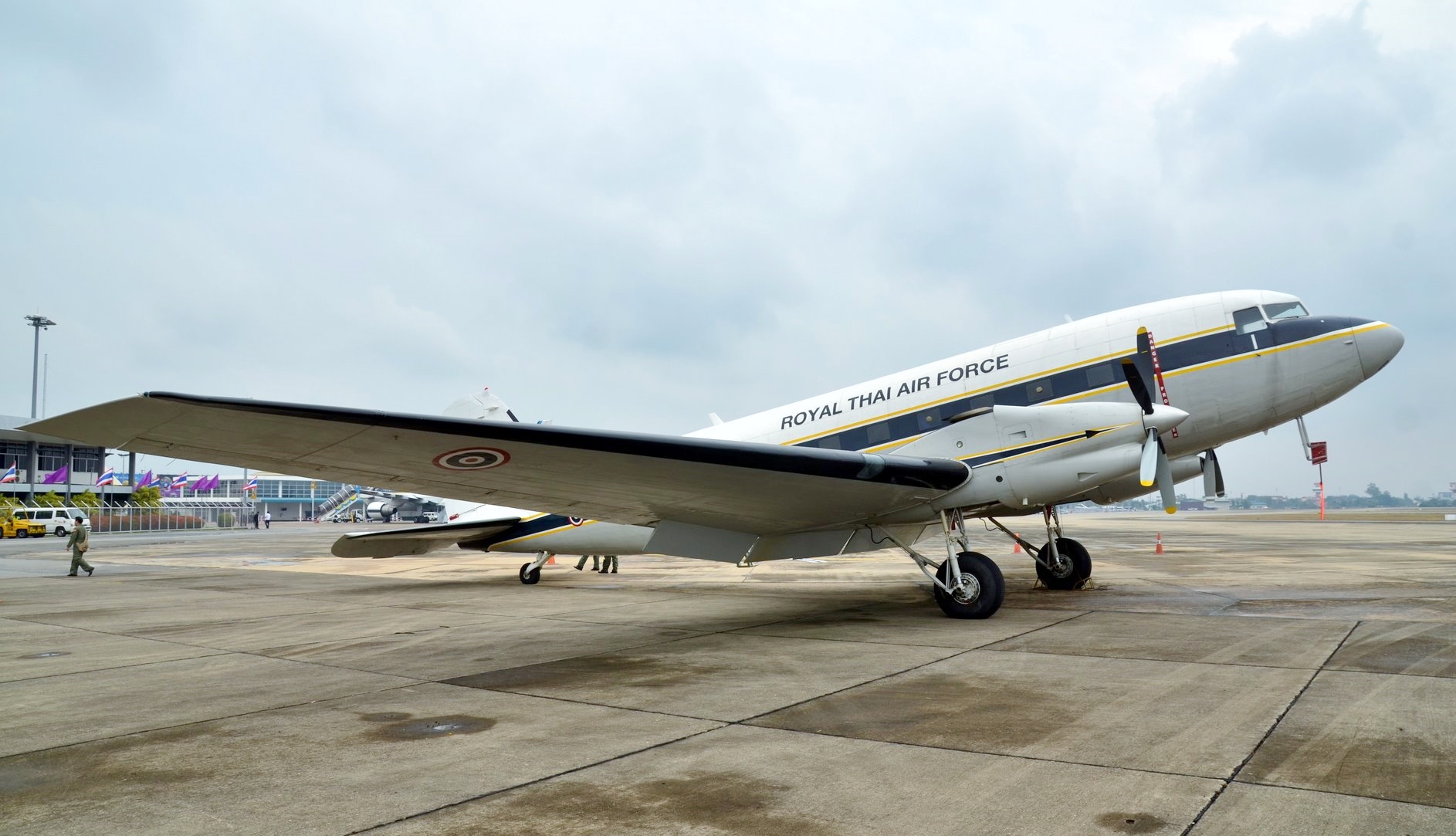 *
*
*
*
*
*
*
*
*
*
*
*
*
*
*
*
*
*
*
*
*
*
*
*
*
*
*
*
*
*
*
*
*
*
*
*
*
*
*
*
*
*
*
*
*
*
*
*
*
*
*
*
*
*
*
*
*
*
*
*
*
*
*
*
*
*
*
*
*
*
*
*
*
*
*
*
*
*
*
*
*
*
*
*
*
*
*
*
*
*

Boeing: Historical Snapshot: C-47 Skytrain military transportManual: (1943) T.O. No. 01-40NC-1 Pilot's Flight Operating Instructions C-47 Airplane
* {{ADF aircraft designations Aircraft first flown in 1941 C-047 Skytrain Douglas DC-3 Low-wing aircraft Twin piston-engined tractor aircraft Douglas C-047 Skytrain
RAAF
"Through Adversity to the Stars"
, colours =
, colours_label =
, march =
, mascot =
, anniversaries = RAAF Anniversary Commemoration ...
, RCAF
The Royal Canadian Air Force (RCAF; french: Aviation royale canadienne, ARC) is the air and space force of Canada. Its role is to "provide the Canadian Forces with relevant, responsive and effective airpower". The RCAF is one of three environm ...
, RNZAF
The Royal New Zealand Air Force (RNZAF) ( mi, Te Tauaarangi o Aotearoa, "The Warriors of the Sky of New Zealand"; previously ', "War Party of the Blue") is the aerial service branch of the New Zealand Defence Force. It was formed from New Zeal ...
, and SAAF designation) is a military transport aircraft
A military transport aircraft, military cargo aircraft or airlifter is a military-owned transport aircraft used to support military operations by airlifting troops and military equipment. Transport aircraft are crucial to maintaining supply ...
developed from the civilian Douglas DC-3
The Douglas DC-3 is a propeller-driven airliner
manufactured by Douglas Aircraft Company, which had a lasting effect on the airline industry in the 1930s to 1940s and World War II.
It was developed as a larger, improved 14-bed sleeper versi ...
airliner. It was used extensively by the Allies
An alliance is a relationship among people, groups, or states that have joined together for mutual benefit or to achieve some common purpose, whether or not explicit agreement has been worked out among them. Members of an alliance are called ...
during World War II
World War II or the Second World War, often abbreviated as WWII or WW2, was a world war that lasted from 1939 to 1945. It involved the World War II by country, vast majority of the world's countries—including all of the great power ...
and remained in front-line service with various military operators for many years.Parker 2013, pp. 13, 35, 37, 39, 45-47.
Design and development
The C-47 differed from the civilian DC-3 by way of numerous modifications, including being fitted with a cargo door, hoist attachment and strengthened floor - along with a shortened tail cone for glider-towing shackles, and anastrodome
The NRG Astrodome, also known as the Houston Astrodome or simply the Astrodome, is the world's first multi-purpose, domed sports stadium, located in Houston, Texas. It was financed and assisted in development by Roy Hofheinz, mayor of Houston ...
in the cabin roof.Wilson, Stewart. ''Aircraft of WWII''. Fyshwick, ACT, Australia: Aerospace Publications Pty Ltd., 1998. .
During World War II, the armed forces of many countries used the C-47 and modified DC-3s for the transport of troops, cargo, and wounded. The U.S. naval designation was R4D. More than 10,000 aircraft were produced in Long Beach
Long Beach is a city in Los Angeles County, California. It is the 42nd-most populous city in the United States, with a population of 466,742 as of 2020. A charter city, Long Beach is the seventh-most populous city in California.
Incorporat ...
and Santa Monica, California
Santa Monica (; Spanish: ''Santa Mónica'') is a city in Los Angeles County, situated along Santa Monica Bay on California's South Coast. Santa Monica's 2020 U.S. Census population was 93,076. Santa Monica is a popular resort town, owing to ...
, and Oklahoma City, Oklahoma
Oklahoma City (), officially the City of Oklahoma City, and often shortened to OKC, is the capital and largest city of the U.S. state of Oklahoma. The county seat of Oklahoma County, it ranks 20th among United States cities in population, and ...
. Between March 1943 and August 1945, the Oklahoma City plant produced 5,354 C-47s.
The specialized C-53 ''Skytrooper'' troop transport started production in October 1941 at Douglas Aircraft's Santa Monica plant. It lacked the cargo door, hoist attachment, and reinforced floor of the C-47. Only 380 aircraft were produced in all because the C-47 was found to be more versatile.
Super DC-3 (R4D-8)
 Large numbers of DC-3s and surplus C-47s were in commercial use in the United States in the 1940s. In response to proposed changes to the Civil Air Regulations airworthiness requirements that would limit the continuing use of these aircraft, Douglas offered a late-1940s DC-3 conversion to improve takeoff and single-engine performance. This new model, the DC-3S or "Super DC-3", was 39 in (0.99 m) longer. It allowed 30 passengers to be carried, with increased speed to compete with newer airliners. The rearward shift in the center of gravity led to larger tail surfaces and new outer, swept-back wings. More powerful engines were installed along with shorter, jet ejection-type exhaust stacks. These were either 1,475 hp (1,100 kW)
Large numbers of DC-3s and surplus C-47s were in commercial use in the United States in the 1940s. In response to proposed changes to the Civil Air Regulations airworthiness requirements that would limit the continuing use of these aircraft, Douglas offered a late-1940s DC-3 conversion to improve takeoff and single-engine performance. This new model, the DC-3S or "Super DC-3", was 39 in (0.99 m) longer. It allowed 30 passengers to be carried, with increased speed to compete with newer airliners. The rearward shift in the center of gravity led to larger tail surfaces and new outer, swept-back wings. More powerful engines were installed along with shorter, jet ejection-type exhaust stacks. These were either 1,475 hp (1,100 kW) Wright R-1820
The Wright R-1820 Cyclone 9 is an American radial engine developed by Curtiss-Wright, widely used on aircraft in the 1930s through 1950s. It was produced under license in France as the Hispano-Suiza 9V or Hispano-Wright 9V, and in the Soviet Un ...
Cyclones or 1,450 hp (1,081 kW) Pratt & Whitney R-2000 Twin Wasps in larger engine nacelles. Minor changes included wheel-well doors, a partially retractable tailwheel, flush rivets, and low-drag antenna. These all contributed to an increased top speed of . With greater than 75% of the original DC-3/C-47 configuration changed, the modified design was virtually a new aircraft. The first DC-3S made its maiden flight on 23 June 1949.Francillon 1979, pp. 464–465.
The changes fully met the new FAR 4B airworthiness requirements, with significantly improved performance. However, little interest was expressed by commercial operators in the DC-3S. It was too expensive for the smaller operators that were its main target; only three were sold to Capital Airlines. The U.S. Navy and U.S. Marine Corps had 100 of their R4D aircraft modified to Super DC-3 standards as the R4D-8, later redesignated the C-117D.Francillon 1979, pp. 466–467.
Operational history
World War II
 The C-47 was vital to the success of many Allied campaigns, in particular, those at
The C-47 was vital to the success of many Allied campaigns, in particular, those at Guadalcanal
Guadalcanal (; indigenous name: ''Isatabu'') is the principal island in Guadalcanal Province of Solomon Islands, located in the south-western Pacific, northeast of Australia. It is the largest island in the Solomon Islands by area, and the se ...
and in the jungles of New Guinea
New Guinea (; Hiri Motu: ''Niu Gini''; id, Papua, or , historically ) is the world's second-largest island with an area of . Located in Oceania in the southwestern Pacific Ocean, the island is separated from Australia by the wide Torres ...
and Burma
Myanmar, ; UK pronunciations: US pronunciations incl. . Note: Wikipedia's IPA conventions require indicating /r/ even in British English although only some British English speakers pronounce r at the end of syllables. As John C. Wells, Joh ...
, where the C-47 and its naval version, the R4D, made it possible for Allied troops to counter the mobility of the light-traveling Japanese Army. C-47s were used to airlift supplies to the encircled American forces during the Battle of Bastogne
The siege of Bastogne () was an engagement in December 1944 between American and German forces at the Belgian town of Bastogne, as part of the larger Battle of the Bulge. The goal of the German offensive was the harbor at Antwerp. In order to r ...
in Belgium. Possibly its most influential role in military aviation, however, was flying "The Hump
The Hump was the name given by Allied pilots in the Second World War to the eastern end of the Himalayan Mountains over which they flew military transport aircraft from India to China to resupply the Chinese war effort of Chiang Kai-shek ...
" from India into China. The expertise gained flying "The Hump" was later used in the Berlin Airlift
The Berlin Blockade (24 June 1948 – 12 May 1949) was one of the first major international crises of the Cold War. During the multinational occupation of post–World War II Germany, the Soviet Union blocked the Western Allies' railway, ro ...
, in which the C-47 played a major role until the aircraft were replaced by Douglas C-54 Skymaster
The Douglas C-54 Skymaster is a four-engined transport aircraft used by the United States Army Air Forces in World War II and the Korean War. Like the Douglas C-47 Skytrain derived from the DC-3, the C-54 Skymaster was derived from a civilian a ...
s.
In Europe, the C-47 and a specialized paratroop
A paratrooper is a military parachutist—someone trained to parachute into a military operation, and usually functioning as part of an airborne force. Military parachutists (troops) and parachutes were first used on a large scale during Wor ...
variant, the C-53 Skytrooper, were used in vast numbers in the later stages of the war, particularly to tow gliders and drop paratroops. During the invasion of Sicily
The Allied invasion of Sicily, also known as Operation Husky, was a major campaign of World War II in which the Allied forces invaded the island of Sicily in July 1943 and took it from the Axis powers ( Fascist Italy and Nazi Germany). It bega ...
in July 1943, C-47s dropped 4,381 Allied paratroops. More than 50,000 paratroops were dropped by C-47s during the first few days of the D-Day
The Normandy landings were the landing operations and associated airborne operations on Tuesday, 6 June 1944 of the Allied invasion of Normandy in Operation Overlord during World War II. Codenamed Operation Neptune and often referred to as ...
campaign also known as the invasion of Normandy
Operation Overlord was the codename for the Battle of Normandy, the Allied operation that launched the successful invasion of German-occupied Western Europe during World War II. The operation was launched on 6 June 1944 (D-Day) with the Norm ...
, France, in June 1944. In the Pacific War
The Pacific War, sometimes called the Asia–Pacific War, was the theater of World War II that was fought in Asia, the Pacific Ocean, the Indian Ocean, and Oceania. It was geographically the largest theater of the war, including the vas ...
, with careful use of the island landing strips of the Pacific Ocean, C-47s were used for ferrying soldiers serving in the Pacific theater back to the United States.
About 2,000 C-47s (received under Lend-Lease
Lend-Lease, formally the Lend-Lease Act and introduced as An Act to Promote the Defense of the United States (), was a policy under which the United States supplied the United Kingdom, the Soviet Union and other Allied nations with food, oil, ...
) in British and Commonwealth service took the name "Dakota", possibly inspired by the acronym "DACoTA" for Douglas Aircraft Company Transport Aircraft.
The C-47 also earned the informal nickname " gooney bird" in the European theatre of operations.O'Rourke, G.G, CAPT USN. "Of Hosenoses, Stoofs, and Lefthanded Spads". ''United States Naval Institute Proceedings'', July 1968. Other sources attribute this name to the first aircraft, a USMC R2D—the military version of the DC-2—being the first aircraft to land on Midway Island, previously home to the long-winged albatross known as the gooney bird which was native to Midway.
Postwar era
 The
The United States Air Force
The United States Air Force (USAF) is the air service branch of the United States Armed Forces, and is one of the eight uniformed services of the United States. Originally created on 1 August 1907, as a part of the United States Army Si ...
's Strategic Air Command
Strategic Air Command (SAC) was both a United States Department of Defense Specified Command and a United States Air Force (USAF) Major Command responsible for command and control of the strategic bomber and intercontinental ballistic missile ...
had Skytrains in service from 1946 through 1967. The US Air Force's 6th Special Operations Squadron
The 6th Special Operations Squadron is part of the 27th Special Operations Wing (27 SOW) at Cannon Air Force Base, New Mexico. The squadron operates MC-130J Commando II aircraft in support of special operations. The 6th SOS specializes in the u ...
was flying the C-47 until 2008.
With all of their aircraft and pilots having been part of the Indian Air Force prior to independence, both the Indian Air Force
The Indian Air Force (IAF) is the air force, air arm of the Indian Armed Forces. Its complement of personnel and aircraft assets ranks third amongst the air forces of the world. Its primary mission is to secure Indian airspace and to conduct ...
and Pakistan Air Force
, "Be it deserts or seas; all lie under our wings" (traditional)
, colours =
, colours_label =
, march =
, mascot =
, anniversaries = ...
used C-47s to transport supplies to their soldiers fighting in the Indo-Pakistan War of 1947.
After World War II, thousands of surplus C-47s were converted to civilian airline use, some remaining in operation in 2012, as well as being used as private aircraft.
Vietnam War
Several C-47 variations were used in theVietnam War
The Vietnam War (also known by #Names, other names) was a conflict in Vietnam, Laos, and Cambodia from 1 November 1955 to the fall of Saigon on 30 April 1975. It was the second of the Indochina Wars and was officially fought between North Vie ...
by the United States Air Force, including three advanced electronic-warfare variations, which sometimes were called "electric gooneys" designated EC-47N, EC-47P, or EC-47Q depending on the engine used. In addition, HC-47s were used by the 9th Special Operations Squadron to conduct psychological warfare operations over South Vietnam and Laos. Miami Air International, Miami International Airport was a USAF military depot used to convert the commercial DC-3s/C-47s into military use. They came in as commercial aircraft purchased from third-world airlines and were completely stripped, rebuilt, and reconditioned. Long-range fuel tanks were installed, along with upgraded avionics and gun mounts. They left as first-rate military aircraft headed for combat in Vietnam in a variety of missions. EC-47s were also operated by the Vietnamese, Laotian, and Cambodian Air Forces. A gunship variation, using three 7.62 mm miniguns, designated AC-47 "Spooky", often nicknamed " Puff the magic dragon", also was deployed.
Variants




 ;C-47
:Initial military version of the DC-3 had four crew (pilot, co-pilot, navigator, and radio operator) and seats for 27 troops alongside the fuselage interior. "Aerial Ambulances" fitted for casualty evacuation could carry 18 stretcher cases and a medical crew of three; 965 built (including 12 for the United States Navy as R4D-1).
;
:C-47 with a 24-volt electrical system, 5,254 built including USN aircraft designated R4D-5
;RC-47A
:C-47A equipped for photographic reconnaissance and ELINT missions
;SC-47A
:C-47A equipped for Search Air Rescue; redesignated HC-47A in 1962
;VC-47A
:C-47A equipped for VIP transport role
;C-47B
:Powered by R-1830-90 engines with two-speed superchargers (better altitude performance) to cover the
;C-47
:Initial military version of the DC-3 had four crew (pilot, co-pilot, navigator, and radio operator) and seats for 27 troops alongside the fuselage interior. "Aerial Ambulances" fitted for casualty evacuation could carry 18 stretcher cases and a medical crew of three; 965 built (including 12 for the United States Navy as R4D-1).
;
:C-47 with a 24-volt electrical system, 5,254 built including USN aircraft designated R4D-5
;RC-47A
:C-47A equipped for photographic reconnaissance and ELINT missions
;SC-47A
:C-47A equipped for Search Air Rescue; redesignated HC-47A in 1962
;VC-47A
:C-47A equipped for VIP transport role
;C-47B
:Powered by R-1830-90 engines with two-speed superchargers (better altitude performance) to cover the China
China, officially the People's Republic of China (PRC), is a country in East Asia. It is the world's List of countries and dependencies by population, most populous country, with a Population of China, population exceeding 1.4 billion, slig ...
-Burma
Myanmar, ; UK pronunciations: US pronunciations incl. . Note: Wikipedia's IPA conventions require indicating /r/ even in British English although only some British English speakers pronounce r at the end of syllables. As John C. Wells, Joh ...
-India
India, officially the Republic of India (Hindi: ), is a country in South Asia. It is the List of countries and dependencies by area, seventh-largest country by area, the List of countries and dependencies by population, second-most populous ...
routes, 3,364 built
;VC-47B
:C-47B equipped for VIP transport role
;XC-47C
:C-47 tested with Edo Model 78 floats for possible use as a seaplane
;C-47D
:C-47B with second speed (high blower) of engine supercharger disabled or removed after the war
; AC-47D ''Spooky''
:Gunship aircraft with three side-firing .30 in (7.62 mm) Minigun
The M134 Minigun is an American 7.62×51mm NATO six-barrel rotary machine gun with a high rate of fire (2,000 to 6,000 rounds per minute). It features a Gatling-style rotating barrel assembly with an external power source, normally an electric ...
machine guns
;EC-47D
:C-47D with equipment for the Electronics Calibration, of which 26 were so converted by Hayes in 1953; prior to 1962 was designated AC-47D
;NC-47D
:C-47D modified for test roles
;RC-47D
:C-47D equipped for photographic reconnaissance and ELINT missions
;SC-47D
:C-47D equipped for Search Air Rescue; redesignated HC-47D in 1962
;VC-47D
:C-47D equipped for VIP transport role
;C-47E
:Modified cargo variant with space for 27–28 passengers or 18–24 litters
;C-47F
:YC-129 redesignated, Super DC-3 prototype for evaluation by USAF later passed to USN as XR4D-8
;C-47L/M
:C-47H/Js equipped for the support of American Legation United States Naval Attache (ALUSNA) and Military Assistance Advisory Group (MAAG) missions
;EC-47N/P/Q
:C-47A and D aircraft modified for ELINT/ARDF mission, N and P differ in radio bands covered, while Q replaces analog equipment found on the N and P with a digital suite, redesigned antenna equipment and uprated engines
;C-47R
:One C-47M modified for high altitude work, specifically for missions in Ecuador
;C-53 Skytrooper
:Troop transport version of the C-47 that lacked the reinforced cargo floor, large cargo door, and hoist attachment of the C-47 ''Skytrain''. It was dedicated for the troop transport role and could carry 28 passengers in fixed metal seats arranged in rows in the former cargo space; 221 built.
;XC-53A Skytrooper
:One testbed aircraft modified in March 1942 with full-span slotted flaps and hot-air leading edge de-icing. Converted to C-53 standard in 1949 and sold as surplus.
;C-53B Skytrooper
:Winterised and long-range Arctic version of the C-53 with extra fuel tanks in the fuselage and separate navigator's astrodome station for celestial navigation; eight built.
;C-53C Skytrooper
:C-53 with larger port-side access door; 17 built.
;C-53D Skytrooper
:C-53C with 24V DC electrical system and its 28 seats attached to the sides of the fuselage; 159 built.
;C-117A Skytrooper
:C-47B with 24-seat airline-type interior for staff transport use, 16 built.
;VC-117A
:Three redesignated C-117s used in the VIP role
;SC-117A
:One C-117C converted for air-sea rescue
;C-117B/VC-117B
:High-altitude two-speed superchargers replaced by one-speed superchargers, one built and conversions from C-117As all later VC-117B
; C-117D
:USN/USMC R4D-8 redesignated C-117D in 1962.
;LC-117D
:USN/USMC R4D-8L redesignated LC-117D in 1962.
;TC-117D
:USN/USMC R4D-8T redesignated TC-117D in 1962.
;VC-117D
:USN R4D-8Z redesignated VC-117D in 1962.
; YC-129
:Super DC-3 prototype for evaluation by USAF redesignated C-47F and later passed to USN as XR4D-8. Wright R-1820
The Wright R-1820 Cyclone 9 is an American radial engine developed by Curtiss-Wright, widely used on aircraft in the 1930s through 1950s. It was produced under license in France as the Hispano-Suiza 9V or Hispano-Wright 9V, and in the Soviet Un ...
engines uprated to 1425 hp.
;CC-129
:Canadian Forces designation for the C-47 (post-1970)
; XCG-17
:One C-47 tested as a 40-seat troop glider with engines removed and faired over
;R4D-1 Skytrain
:USN/USMC version of the C-47
;R4D-3
:Twenty C-53Cs transferred to USN
;R4D-5
:C-47A variant 24-volt electrical system replacing the 12-volt of the C-47; redesignated C-47H in 1962, 238 transferred from USAF
;R4D-5L
:R4D-5 for use in Antarctica. Redesignated LC-47H in 1962. Photos of this type show the removal of underslung engine oil coolers typical of the R-1830 engine installation; apparently not needed in the cold polar regions.
;R4D-5Q
:R4D-5 for use as special ECM trainer. Redesignated EC-47H in 1962
;R4D-5R
:R4D-5 for use as a personnel transport for 21 passengers and as a trainer aircraft; redesignated TC-47H in 1962
;R4D-5S
:R4D-5 for use as a special ASW trainer; redesignated SC-47H in 1962
;R4D-5Z
:R4D-5 for use as a VIP transport; redesignated VC-47H in 1962
 ;R4D-6
::157 C-47Bs transferred to USN; redesignated C-47J in 1962
;R4D-6L, Q, R, S, and Z
:Variants as the R4D-5 series; redesignated LC-47J, EC-47J, TC-47J, SC-47J, and VC-47J respectively in 1962
;R4D-7
:44 TC-47Bs transferred from USAF for use as a navigational trainer; redesignated TC-47K in 1962
;
;R4D-6
::157 C-47Bs transferred to USN; redesignated C-47J in 1962
;R4D-6L, Q, R, S, and Z
:Variants as the R4D-5 series; redesignated LC-47J, EC-47J, TC-47J, SC-47J, and VC-47J respectively in 1962
;R4D-7
:44 TC-47Bs transferred from USAF for use as a navigational trainer; redesignated TC-47K in 1962
;R4D-8
The Douglas R4D-8 (later redesignated C-117D) is a military transport aircraft developed from the civilian Douglas DC-3S (Super DC-3) airliner. It was used by the United States Navy and United States Marine Corps during the Korean War and Vi ...
:R4D-5 and R4D-6 remanufactured aircraft with stretched fuselage, Wright R-1820
The Wright R-1820 Cyclone 9 is an American radial engine developed by Curtiss-Wright, widely used on aircraft in the 1930s through 1950s. It was produced under license in France as the Hispano-Suiza 9V or Hispano-Wright 9V, and in the Soviet Un ...
engines, fitted with modified wings and redesigned tail surfaces; redesignated C-117D in 1962
;R4D-8L
:R4D-8 converted for Antarctic use, redesignated LC-117D in 1962
;R4D-8T
:R4D-8 converted as crew trainers, redesignated TC-117D in 1962
;R4D-8Z
:R4D-8 converted as a staff transport, redesignated VC-117D in 1962
;C-47TP "Turbo Dak"
:Refit with two Pratt & Whitney Canada PT6A-67R engines and fuselage stretch for the South African Air Force
;Basler BT-67
The Basler BT-67 is a utility aircraft produced by Basler Turbo Conversions of Oshkosh, Wisconsin. It is a remanufactured and modified Douglas DC-3; the modifications are designed to significantly extend the DC-3's serviceable lifetime.
Design ...
:C-47 conversion with a stretched fuselage, strengthened structure, modern avionics, and powered by two Pratt & Whitney Canada PT-6A-67R turboprops
RAF designations
 ;Dakota I
:RAF designation for the C-47 and R4D-1.
;Dakota II
:RAF designation for nine C-53 Skytroopers received under the lend lease scheme. Unlike the majority of RAF Dakotas, these aircraft were therefore dedicated troop transports, lacking the wide cargo doors and reinforced floor of the C-47.
;Dakota III
:RAF designation for the C-47A.
;Dakota IV
:RAF designation for the C-47B.
;Airspeed AS.61
:Projected conversion of Dakota I aircraft by Airspeed. None built.
;Airspeed AS.62
:Projected conversion of Dakota II aircraft by Airspeed. None built.
;Airspeed AS.63
:Projected conversion of Dakota III aircraft by Airspeed. None built.
;BEA Pionair/Dart-Dakota
:Conversion of Dakota to
;Dakota I
:RAF designation for the C-47 and R4D-1.
;Dakota II
:RAF designation for nine C-53 Skytroopers received under the lend lease scheme. Unlike the majority of RAF Dakotas, these aircraft were therefore dedicated troop transports, lacking the wide cargo doors and reinforced floor of the C-47.
;Dakota III
:RAF designation for the C-47A.
;Dakota IV
:RAF designation for the C-47B.
;Airspeed AS.61
:Projected conversion of Dakota I aircraft by Airspeed. None built.
;Airspeed AS.62
:Projected conversion of Dakota II aircraft by Airspeed. None built.
;Airspeed AS.63
:Projected conversion of Dakota III aircraft by Airspeed. None built.
;BEA Pionair/Dart-Dakota
:Conversion of Dakota to Rolls-Royce Dart
The Rolls-Royce RB.53 Dart is a turboprop engine designed and manufactured by Rolls-Royce Limited. First run in 1946, it powered the Vickers Viscount on its maiden flight in 1948. A flight on July 29 of that year, which carried 14 paying passe ...
power and used by BEA to prove turboprop engines prior to entry into service of Vickers Viscount
The Vickers Viscount is a British medium-range turboprop airliner first flown in 1948 by Vickers-Armstrongs. A design requirement from the Brabazon Committee, it entered service in 1953 and was the first turboprop-powered airliner.
The Vi ...
.
Aftermarket conversions
Operators


Laos
Laos (, ''Lāo'' )), officially the Lao People's Democratic Republic ( Lao: ສາທາລະນະລັດ ປະຊາທິປະໄຕ ປະຊາຊົນລາວ, French: République démocratique populaire lao), is a socialist s ...
*
*
*
*
*
*
*
*
*
*
*
*
*
*
*
*
*
*
*
*
*
*
*
*
*
*
*
*
*
*
*
*
*
* (also as Lisunov Li-2
The Lisunov Li-2 (NATO reporting name: Cab), originally designated PS-84, was a license-built Soviet-version of the Douglas DC-3. It was produced by Factory #84 in Moscow-Khimki and, after evacuation in 1941, at TAPO in Tashkent. The pr ...
)
*
*
*
*
*
*
*
*
*
*
*
*
*
*
*
*
*
*
*
*
*
Accidents and incidents
Surviving aircraft
Large numbers of C-47s, C-117s and other variants survive, on display in museums or as monuments; operated aswarbird
A warbird is any vintage military aircraft now operated by civilian organizations and individuals, or in some instances, by historic arms of military forces, such as the Battle of Britain Memorial Flight, the RAAF Museum Historic Flight, or th ...
s; or remaining in service.
As part of the D-Day
The Normandy landings were the landing operations and associated airborne operations on Tuesday, 6 June 1944 of the Allied invasion of Normandy in Operation Overlord during World War II. Codenamed Operation Neptune and often referred to as ...
75th-anniversary commemoration in June 2019, 14 American C-47s (including ''That's All, Brother''; ''Betsy's Biscuit Bomber''; ''Miss Montana''; ''Spirit of Benovia''; ''D-Day Doll''; ''Boogie Baby''; N47E ''Miss Virginia''; and ''Whiskey 7'' ), and another group of 'Daks' from Europe retraced the route across the English Channel to Normandy
Normandy (; french: link=no, Normandie ; nrf, Normaundie, Nouormandie ; from Old French , plural of ''Normant'', originally from the word for "northman" in several Scandinavian languages) is a geographical and cultural region in Northwestern ...
taken by roughly 850 of these aircraft on D-Day.
Specifications (C-47B-DK)

See also
References
Notes
Citations
Bibliography
* * Chorlton, Martyn. ''Paths in the Wood''. Cowbit, UK: Old Forge Publishing Ltd, 2003. . * * Donald, David. ''The Complete Encyclopedia of World Aircraft''. New York: Barnes & Noble, 1997. . * Flintham, Victor. ''Air Wars and Aircraft: A Detailed Record of Air Combat, 1945 to the Present''. New York: Facts on File, 1990. . * Francillon, René J. ''McDonnell Douglas Aircraft Since 1920''. London: Putnam & Company, 1979. . * Gradidge, Jennifer M. ''The Douglas DC-1, DC-2, DC-3: The First Seventy Years''. Two volumes. Tonbridge, UK: Air-Britain (Historians) Ltd., 2006. . * Herman, Arthur. ''Freedom's Forge: How American Business Produced Victory in World War II''. New York: Random House, 2012. . * Kaplan, Philip. ''Legend: A Celebration of the Douglas DC-3/C-47/Dakota''. Peter Livanos & Philip Kaplan, 2009. . * Parker, Dana T. ''Building Victory: Aircraft Manufacturing in the Los Angeles Area in World War II''. Cypress, California: Dana Parker Enterprises, 2013. . * Pearcy, Arthur Jr. "Douglas R4D variants (US Navy's DC-3/C-47)". ''Aircraft in Profile, Volume 14''. Windsor, Berkshire, UK: Profile Publications, 1974, pp. 49–73. . * * * * Yenne, Bill. ''McDonnell Douglas: A Tale of Two Giants''. Greenwich, Connecticut: Bison Books, 1985. .External links
Boeing: Historical Snapshot: C-47 Skytrain military transport
* {{ADF aircraft designations Aircraft first flown in 1941 C-047 Skytrain Douglas DC-3 Low-wing aircraft Twin piston-engined tractor aircraft Douglas C-047 Skytrain
Douglas C-47 Skytrain
The Douglas C-47 Skytrain or Dakota ( RAF, RAAF, RCAF, RNZAF, and SAAF designation) is a military transport aircraft developed from the civilian Douglas DC-3 airliner. It was used extensively by the Allies during World War II and remained ...
World War II aircraft of Finland